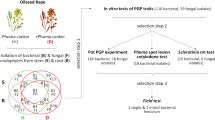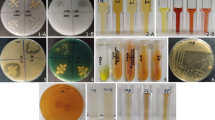Abstract
Substantial yield losses of Styrian oil pumpkin caused by the fungus Didymella bryoniae and bacterial pathogens were recently reported. Here we applied bacterial endophytes with a broad antagonistic activity to pumpkin plants by seed priming. Effects of the bacterial inoculants with and without chemical seed treatments on plant growth and health were evaluated during three different field trials in two consecutive years (2010 and 2011). Biological seed treatments strongly supported the germination of pumpkin seeds. In 2010, the germination of the biologically treated seeds was comparable to the rate following a chemical treatment; whilst in 2011 effects of biological seed treatments were more obvious, including an increased emergence rate up to 109 % by Serratia plymuthica S13. Furthermore, tolerance against desiccation stress was observed for Serratia as well as for Lysobacter gummosus L101 treatment. The biological treatment showed different effects against fungal diseases: no effect on fruit rot was observed, whereas powdery mildew could be significantly suppressed by Paenibacillus polymyxa PB71 and L. gummosus L101 in 2010. In addition, both strains led to reproducible increases in harvest yields. In this study, we found bacterial endophytes suitable as inoculants for plant growth promotion, biocontrol, as well as for enhancing stress tolerance in Styrian oil pumpkins.



Similar content being viewed by others
Abbreviations
- cw:
-
calendar week
References
Babadoost, M., & Zitter, T. A. (2009). Fruit rots of pumpkin. Plant Disease, 93, 772–782.
Berg, G., & Hallmann, J. (2006). Control of plant pathogenic fungi with bacterial endophytes. In B. Schulz, C. Boyle, & T. Sieber (Eds.), Microbial root endophytes (pp. 53–70). Berlin: Springer.
Berg, G. (2009). Plant-microbe interactions promoting plant growth and health: perspectives for controlled use of microorganisms in agriculture. Applied Microbiology and Biotechnology, 84, 11–18.
Berg, G., Zachow, C., Cardinale, M., & Müller, H. (2009). Ecology and human pathogenicity of plant-associated bacteria. In R. U. Ehlers (Ed.), Regulation of biological control agents (pp. 175–189). Berlin: Springer.
Compant, S., Duffy, B., Nowak, J., Clement, C., & Barka, E. A. (2005). Use of plant growth-promoting bacteria for biocontrol of plant diseases: principles, mechanisms of action, and future prospects. Applied and Environmental Microbiology, 71, 4951–9.
Dreikorn, K. (2002). The role of phytotherapy in treating lower urinary tract symptoms and benign prostatic hyperplasia. World Journal of Urology, 19, 426–35.
Fruehwirth, G. O., & Hermetter, A. (2007). Seeds and oil of the Styrian oil pumpkin: components and biological activities. European Journal of Lipid Science and Technology, 109, 1128–1140.
Fürnkranz, M., Lukesch, B., Muller, H., Huss, H., Grube, M., & Berg, G. (2012). Microbial diversity inside pumpkins: microhabitat-specific communities display a high antagonistic potential against phytopathogens. Microbial Ecology, 63, 418–28.
Huss, H. (2007). Didymella bryoniae im Steirischen Ölkürbis: Neben Fruchtfäule auch Verursacher der Blattdürre. Der Pflanzenarzt, 60, 10–11.
Huss, H., & Mavridis, A. (2007). Bakterium Pseudomonas viridiflava: Neue Blattfleckenkrankheit am Steirischen Ölkürbis. Der Pflanzenarzt, 60, 8–9.
Huss, H., Winkler, J., & Greimel, C. (2007). Der Pilz Didymella bryoniae schädigt steirischen Ölkürbisanbau: Fruchtfäule statt Kernöl. Der Pflanzenarzt, 60, 14–16.
Huss, H., Mavridis, A., & Eitzinger, J. (2009). Bakterien-Weichfäule bei Ölkürbis: Weiche Schale, keine Kerne. Der Pflanzenarzt, 14, 14–15.
Huss, H., & Winkler, J. (2009). Neue virusbedingte Krankheitsbilder bei Ölkürbis: Gefährlich schön gescheckt. Der Pflanzenarzt, 62, 12–13.
Huss, H. (2011). Krankheiten und Schädlinge im Ölkürbisbau. Der fortschrittliche Landwirt, 3, 30–33.
Keinath, A. P. (2011). From native plants in Central Europe to cultivated crops worldwide: the emergence of Didymella bryoniae as a cucurbit pathogen. Hortscience, 46(4), 532–535.
Koo, S. Y., & Cho, K. S. (2009). Isolation and characterization of a plant-growth-promoting rhizobacterium, Serratia sp. SY5. Journal of Microbiology and Biotechnology, 19, 1431–1438.
Lee, D.-H., Mathur, S. B., & Neergaard, P. (1984). Detection and location of seed-borne inoculum of Didymella bryoniae and its transmission in seedlings of cucumber and pumpkin. Journal of Phytopathology, 109, 301–308.
Lugtenberg, B., & Kamilova, F. (2009). Plant-growth-promoting rhizobacteria. Annual Review of Microbiology, 63, 541–56.
Mei, C., & Flinn, B. S. (2010). The use of beneficial microbial endophytes for plant biomass and stress tolerance improvement. Recent Patents on Biotechnology, 4, 81–95.
Müller, H., & Berg, G. (2008). Impact of formulation procedures on the effect of Serratia plymuthica on Verticillium wilt in oilseed rape. BioControl, 53, 905–916.
Müller, H., Westendorf, C., Leitner, E., Chernin, L., Riedel, K., Schmidt, S., et al. (2009). Quorum-sensing effects in the antagonistic rhizosphere bacterium Serratia plymuthica HRO-C48. FEMS Microbiology Ecology, 67, 468–78.
Rademaker, J. L. W., & de Bruijn, F. J. (1997). Characterization and classification of microbes by REP-PCR genomic fingerprinting and computer-assisted pattern analysis. In G. Caetano-Anollés & P. M. Gresshoff (Eds.), DNA markers: protocols, applications and overviews (pp. 151–171). New York: Wiley.
Reddy, M. S., Hynes, R. K., & Lazarovits, G. (1993). Relationship between in vitro growth inhibition of pathogens and suppression of preemergence dam**-off and postemergence root rot of white bean seedlings in the greenhouse by bacteria. Canadian Journal of Microbiology, 40, 113–119.
Sessitsch, A., Coenye, T., Sturz, A. V., Vandamme, P., Barka, E. A., Salles, J. F., et al. (2005). Burkholderia phytofirmans sp. nov., a novel plant-associated bacterium with plant-beneficial properties. International Journal of Systematic and Evolutionary Microbiology, 55, 1187–1192.
Sitterly, W. R., & Keinath, A. P. (1996). Gummy stem blight. In T. A. Zitter, D. L. Hopkins, & C. E. Thomas (Eds.), Compendium of cucurbit diseases (pp. 27–28). St. Paul: American Phytological Society Press.
Teppner, H. (2000). Cucurbita pepo (Cucurbitaceae) - history, seed coat types, thin coated seeds and their genetics. Phyton Annales Rei Botanicae, 40, 1–208.
Trnka, M., Eitzinger, J., Dubrovský, M., Semerádová, D., Stepánek, P., Hlavinka, P., et al. (2010). Is rainfed crop production in central Europe at risk? Using a regional climate model to produce high resolution agroclimatic information for decision makers. Journal of Agricultural Science, 148, 639–656.
Weller, D. M., & Cook, R. J. (1983). Suppression of take-all of wheat by seed-treatment with fluorescent pseudomonads. Phytopathology, 73, 463–469.
Acknowledgements
We thank Bernhard Stuphann and Christoph Hirschbauer (Alwera AG, Gleisdorf) for providing oil pumpkin seeds for field trials II and III. Furthermore, we wish to thank Christin Zachow (Graz) for assistance during the field work. The project was funded by the Austrian Federal Ministry of Agriculture, Forestry, Environment and Water Management and the government of the Federal State of Styria.
Author information
Authors and Affiliations
Corresponding author
Electronic supplementary material
Below is the link to the electronic supplementary material.
ESM 1
Electronic supplementary material (PDF 587 kb)
Rights and permissions
About this article
Cite this article
Fürnkranz, M., Adam, E., Müller, H. et al. Promotion of growth, health and stress tolerance of Styrian oil pumpkins by bacterial endophytes. Eur J Plant Pathol 134, 509–519 (2012). https://doi.org/10.1007/s10658-012-0033-2
Accepted:
Published:
Issue Date:
DOI: https://doi.org/10.1007/s10658-012-0033-2




